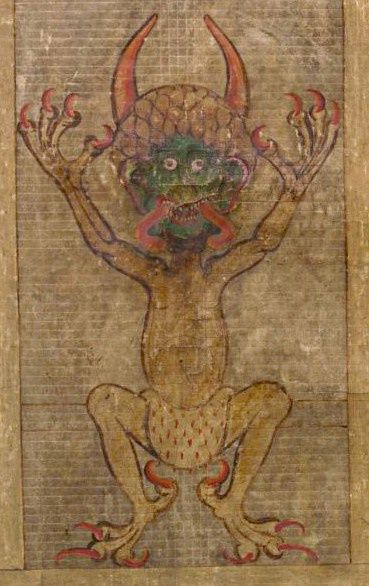Difference between revisions of "Template:POTD protected"
Jump to navigation
Jump to search
Occultwiki (talk | contribs) Tag: Manual revert |
Occultwiki (talk | contribs) |
||
| (31 intermediate revisions by the same user not shown) | |||
| Line 1: | Line 1: | ||
{| role="presentation" style="margin:0 3px 3px; width:100%; text-align:left; background-color:transparent; border-collapse: collapse; " | {| role="presentation" style="margin:0 3px 3px; width:100%; text-align:left; background-color:transparent; border-collapse: collapse; " | ||
|style="padding:0 0.9em 0 0;" | [[File: | |style="padding:0 0.9em 0 0;" | [[File:Codex Gigas devil.jpg|300px|thumb|]] | ||
|style="padding:0 6px 0 0"| | |style="padding:0 6px 0 0"| | ||
'''[[ | '''[[Satan]]''', also known as [[The Devil]] is an entity in the [[Abrahamic religion]]s that seduces humans into sin or falsehood. In [[Judaism]], Satan is seen as an agent subservient to [[Yahweh|God]], typically regarded as a metaphor for the'' yetzer hara'', or "evil inclination." In [[Christianity]] and [[Islam]], he is usually seen as a [[fallen angel]] that has rebelled against God, who nevertheless allows him temporary power over the fallen world and a host of [[demon]]s. | ||
<p><small>Author: Herman the Recluse</small></p> | |||
<p><small> | |||
[[:Category:Images|'''(More Images)''']] | [[:Category:Images|'''(More Images)''']] | ||
<div class="potd-recent" style="text-align:right;"> | <div class="potd-recent" style="text-align:right;"> | ||
Latest revision as of 06:59, 14 December 2025
|
Satan, also known as The Devil is an entity in the Abrahamic religions that seduces humans into sin or falsehood. In Judaism, Satan is seen as an agent subservient to God, typically regarded as a metaphor for the yetzer hara, or "evil inclination." In Christianity and Islam, he is usually seen as a fallen angel that has rebelled against God, who nevertheless allows him temporary power over the fallen world and a host of demons.
Author: Herman the Recluse |
